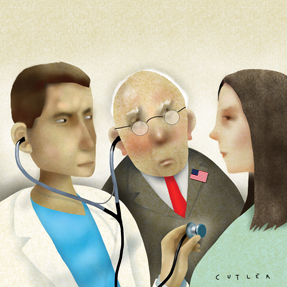Antidepressants no easy fix in primary care
Is depression on the rise, or just the prescriptions for it? Primary care is poised to play a bigger role in mental health care, and that puts an educational burden on internists to learn the proper role of medications.
The patient reports a problem sleeping, says he doesn't feel well in general, or comes right out and asks for an antidepressant he's seen advertised. As the appointment hits the 15-minute mark, time-pressured and possibly underprepared primary care physicians sometimes respond by reaching for their prescription pads even if they don't record a psychiatric diagnosis.
Yet at the same time, primary care physicians may be missing or treating without diagnosing those who really do have depression, a number pegged at 5.4% of Americans over age 12, according to a 2005-2006 report from the Centers for Disease Control and Prevention.
Because of recent growing trends toward collaboration of care and fewer medical students choosing to enter psychiatry, there is general agreement that primary care settings will be playing a larger role in mental health care, particularly for less severe cases. But experts and new study results conclude that primary care physicians need to go beyond antidepressant prescriptions to learn more about screening, diagnosing and treating patients for depression, as well as convince their patients that they're right for the job.
“Some say mental health care in the primary care setting is the wave of the future,” said ACP Member Robert M. McCarron, DO, training director of internal medicine/psychiatry residency at the University of California, Davis School of Medicine. “I say it's the wave of the present, and that's a good thing.”
The prescribing trend
Without enough time to really talk to patients about depression and with some patients increasingly open to the idea of an antidepressant for mild conditions, the primary care setting can be vulnerable to overprescribing, said Ramin Mojtabai, MD, PhD, MPH, associate professor in the department of mental health at the Johns Hopkins Bloomberg School of Public Health in Baltimore.
That may explain what he considers the surprising result of a study he co-authored, which was published in the August 2011 Health Affairs: Prescriptions for antidepressants by nonpsychiatrists without a psychiatric diagnosis rose from 59.5% of antidepressant visits to 72.7% from 1996 to 2007, and from 3.1% to 7.1% of all visits to primary care clinicians.
Those prescriptions may have been warranted, but if, as in Dr. Mojtabai's study, information isn't available about what happens to patients after they receive them, it's hard to know if some could have done just as well on a placebo or with some other type of therapy. If nothing else, it may indicate that primary care physicians are not always using clinical evidence in making those decisions, he said.
The prescribing trend is a big change from how primary care physicians have worked in the not-so-distant past, according to Jürgen Unützer, MD, MPH, MA, professor and vice chair of psychiatry and behavioral sciences and chief of psychiatry at the University of Washington Medical Center in Seattle.
“If you go back 15 to 20 years it was relatively rare to start antidepressants in the primary care setting. Now almost 30 million [people] walk out of a physician's office with a prescription for an antidepressant each year. This is in part because the newer generation of medications is easy to use so doctors are willing to give it a try,” he said.
But, he added, he's concerned that an increasing number of those patients may not have a psychiatric diagnosis. “I don't like it. I think everybody who's being treated for depression should have a diagnosis,” said Dr. Unützer.
Why patients resist
While some patients clamor for antidepressants, however, not all who may truly benefit from discussing their symptoms want to talk about them. And not all physicians are trained to ask the right questions or use tools that can make the most of their limited time to nail the diagnosis.
A study published in the September/October 2011 Annals of Family Medicine found that 43% of 1,054 adults surveyed had one or more reasons why they wouldn't want to disclose their symptoms of depression. Richard L. Kravitz, MD, FACP, MSPH, an author of that study, said those reasons fall into the following categories:
- Fear of treatment. Patients are concerned that their physician will recommend a treatment they don't want, that the diagnosis will lead to a pill that they've heard bad things about, or that they will be sent to a psychiatrist.
- Concern about stigma. Although the stigma associated with a mental health diagnosis may have lessened recently, it still exists, particularly in certain demographics. Additionally, patients are concerned about potential ramifications with their employer or insurer if they are being treated for depression. Stigma concerns could help explain the stats about prescribing antidepressants without a psychiatric diagnosis: Physicians don't want to name the diagnosis because of the stigma, so they call it something else, such as fatigue, said Michael S. Klinkman, MD, MS, a professor in the departments of family medicine and psychiatry at the University of Michigan Medical School in Ann Arbor.
- Concern about the physician's role. Some patients feel it isn't their primary care physician's job to deal with depression, that their physician may not be trained to deal with their emotional problems, and that bringing emotional issues into the relationship would distract from taking care of their physical problems. They also might feel that the primary care physician doesn't have time to listen, so it's not worth beginning the conversation.
Good communication can help counter those concerns.
“The nature of the placebo in primary care is the relationship with the doctor. Just asking questions and having the patient come back for follow-up may be as much, if not more, therapeutic as the prescription,” said Dr. Kravitz, professor and co-vice chair of research at the University of California, Davis division of general medicine.
The problem is some physicians may not have enough training in behavioral medicine to know what questions to ask, putting both them and their patients at a disadvantage, said Dr. McCarron, who is president of the Association of Medicine and Psychiatry and editorial consultant for the depression module in ACP's Physicians' Information and Education Resource (PIER).
Just open the door to discussing depression and most patients will respond, Dr. Kravitz said. He recommended the following steps:
- Use an open-ended agenda, creating space early in the visit.
- Use questions like, “Is there anything else you want to discuss today?
- Be attuned to nonverbal cues. Then say, if appropriate, “You don't seem to have your usual energy,” or “You look a little down,” or “You seem distracted.”
- Follow that with, “I was wondering if anything else is happening?”
- Dispel worries that the primary care physician is not the right person to discuss and treat depression. Say, “Depression is an illness like any other and it's just as much my job to try to help with that as it is with heart disease or cholesterol.”
Dr. Kravitz added, “These questions sound a little psychotherapeutic, but the average [primary care physician] is fully capable of enacting them.”
The right tools
Experts say another way to jump-start the conversation is by using screening tools like the PHQ-9.
The PHQ-9 can help identify if antidepressants are indicated, and if started, monitor a patient's response to them, said Sophia Chang, MD, MPH, director of better chronic disease care at the California Healthcare Foundation in Oakland.
“This isn't gestalt. There are real metrics to use and rigor can be brought to this. That should make doctors more comfortable and lead to better outcomes,” Dr. Chang said.
ACP Member Damara Gutnick, MD, said using the PHQ-9 in a depression collaborative for patients already part of chronic disease management at Bellevue Hospital in New York has been eye-opening (see sidebar).
“I used to think that asking questions was like opening a Pandora's box. Here come the tears and that's going to take a lot of time,” said Dr. Gutnick, clinical assistant professor of medicine and psychiatry at the NYU/Langone Medical Center in New York and physician champion for the NYC Health and Hospital's Chronic Disease Depression Collaborative. “Now I just say, ‘Let's review your answers to the questionnaire you completed in the waiting room. It sounds like you are really suffering from some of the symptoms of depression, what do you think of that?’ That opens the conversation. I make sure I have the tissue box at hand.”
Practices can use the tools in different ways. For example, each patient could get the PHQ-2 in the waiting room (screening everyone helps remove any stigma). Those with positive results could then get the PHQ-9.
Dr. Gutnick emphasized that any positive response to the ninth question, which addresses suicidality, should be addressed immediately.
Dr. Chang added that the screen can be used as a metric to monitor response to antidepressants and change or escalate doses appropriately, similar to blood pressure readings when monitoring antihypertensive therapy.
Dr. McCarron noted that it's time to refer to a psychiatrist when a patient hasn't responded to treatment (for example, the first two medications prescribed), if the patient shows signs of a comorbid psychiatric condition such as bipolar illness, or if the patient has active suicidal ideation or has made suicide attempts.
(For more information on depression care, visit the ACP Depression Care Guide. )
Why collaborative care works
Just as for other disease management programs, structured follow-up and monitoring for patients on antidepressants done in coordination with primary care can offset the limitations of the short clinical visit, Dr. Klinkman said.
This kind of intervention is recommended by the Centers for Disease Control and Prevention's Community Preventive Services Task Force and is the cornerstone of the well-known IMPACT model for evidence-based depression care . The latter program, which is directed by Dr. Unützer, uses the following stepped-care plan:
- Adjust treatment based on clinical outcomes and according to an evidence-based algorithm.
- Aim treatment to reduce symptoms by 50% within 10 to 12 weeks.
- Change the plan if the patient is not significantly improved at 10 to 12 weeks after treatment starts. The change can be an increase in medication dosage, a change to a different medication, the addition of psychotherapy, a combination of medication and psychotherapy, or other treatments suggested by the team psychiatrist.
Dr. Gutnick noted that Bellevue uses two depression care managers who collaborate with physicians. But how can a small group practice or even a larger one without resources afford this kind of collaborative care, a solution that Dr. Kravitz calls “tantalizing but frustrating”?
“Think about treating mental health problems the same way you treat other chronic diseases,” Dr. Klinkman said. For instance, make it part of a medical home that includes care management resources for those illnesses or designate or hire someone to manage mental health for the practice or to share among practices.
In Dr. McCarron's opinion, collaborative care is worth the investment of both time and money. “I'm a fan,” he said. “I use it personally, I teach it, and I try to establish these changes throughout the state.”





